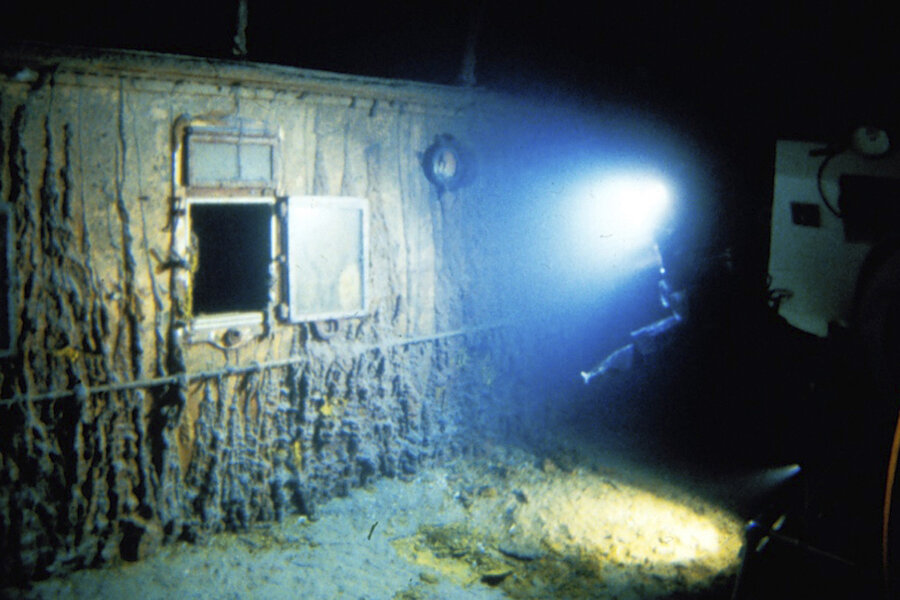‘Hallowed ground’: Titanic footage released of 1986 dive
Loading...
| Falmouth, Mass.
The sheer size of the vessel and the shoes were what struck Robert Ballard when he descended to the wreckage of the RMS Titanic in 1986, the year after he and his crew from the Woods Hole Oceanographic Institution helped find the ocean liner that struck an iceberg and sank in the North Atlantic in 1912.
“The first thing I saw coming out of the gloom at 30 feet was this wall, this giant wall of riveted steel that rose over 100 and some feet above us,” he said in an interview from Connecticut on Wednesday, the same day the WHOI released on 80 minutes of never before publicly seen underwater video of the expedition to the wreckage.
“I never looked down at the Titanic. I looked up at the Titanic. Nothing was small,” he said.
The crew of Alvin, the three-person submersible he was in, headed to the surface when it started taking water into its batteries, and as it rose, Mr. Ballard saw the Titanic’s portholes.
“It was like people looking back at us. It was pretty haunting actually,” he said.
There were no skeletal bones left, but he saw shoes, including the footwear of what appeared to be a mother and a baby, that looked like tombstones marking the spot where some of the roughly 1,500 people who perished came to rest on the ocean floor.
“After the Titanic sank, those that went into the water that didn’t have life jackets died of hypothermia and their bodies came raining down,” he said.
The liner sank on its maiden voyage from Southampton, England, to New York City after hitting an iceberg in the early morning hours of April 15, 1912.
The WHOI team, in partnership with the French oceanographic exploration organization Institut français de recherche pour l’exploitation de la mer, discovered the final resting place of the ship in 12,400 feet of water on Sept. 1, 1985, using a towed underwater camera.
The newly released footage was from a return expedition the following year.
There had been prior efforts to find the wreck. But the 1985 discovery and the 1986 trip were made possible by sophisticated underwater vehicles that could withstand the unforgiving conditions, said WHOI engineer Andy Bowen, who helped develop them.
“The water is near freezing temperatures and probably the biggest challenge is the remoteness of the location, and in particular the harsh environment with regard to the pressure our equipment is exposed to,” he said.
Mr. Ballard said he went through the gamut of emotions during the 1985 mission.
He was concerned that the public would figure out that he was a Naval intelligence officer who was on a top-secret Cold War mission funded by the Navy to study the wrecks of two nuclear submarines that had also gone down in the North Atlantic. The search for the Titanic was a bit of an afterthought.
“I wasn’t a Titanic groupie,” he said. “I was heavily involved in my military program. So I wasn’t expecting to be affected by the discovery.”
The ship sank at about 2:20 a.m. The 1985 discovery using the underwater camera occurred at about 2 a.m.
Mr. Ballard recalled one of the crew glancing at the clock and saying, “She sinks in 20 minutes.”
“We actually stopped the operation and raised the vehicle to gather my thoughts and I said, ‘I’m going to go outside and just get myself back together’ and everyone else followed,” he said. “We had a small memorial service for all those that had died. But we were there, we were at this spot.”
It was hallowed ground, like at the Gettysburg battlefield, he said.
The video, much of it haunting and grainy interiors of the ship taken by the remotely operated underwater exploration vehicle Jason Jr., is being released in conjunction with the 25th anniversary release on Feb. 10 of the remastered version of the Academy Award-winning movie “Titanic.”
“More than a century after the loss of Titanic, the human stories embodied in the great ship continue to resonate,” James Cameron, the film’s director, said in a statement. “Like many, I was transfixed when Alvin and Jason Jr. ventured down to and inside the wreck. By releasing this footage, WHOI is helping tell an important part of a story that spans generations and circles the globe.”
The story of the Titanic fascinates people to this day for many reasons, Mr. Ballard said. It was at the time the world’s largest ocean liner and was supposed to be virtually unsinkable. Its passengers included some of the world’s most wealthy and famous. And in the aftermath, the world heard remarkable stories of heroism and bravery by the crew and passengers.
He said: “I think everyone wonders in their own mind, ‘If I were there, what would I have done?’”
This story was reported by The Associated Press. AP writer Mark Pratt reported from Boston.







